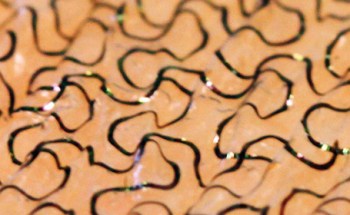Jun 10 2013
In the not-so-distant future, patients with heart disease won’t have to strap brick-size Holter monitors to their arms or waists, with webs of electrodes connected to their chests to monitor their hearts. Those unable to speak will communicate by muscle movements in their throats, and the blind will read with finger tubes that “poke” their fingertips with programmable electrotactile stimulations in place of bulky brail.
 Nanshu Lu is the mind behind the design of the electronic tattoo, an intricate arrangement of serpentine-like micro-wires and silicon that measures vital signs and muscle movement. [Images courtesy of the Department of Aerospace Engineering & Engineering Mechanics]
Nanshu Lu is the mind behind the design of the electronic tattoo, an intricate arrangement of serpentine-like micro-wires and silicon that measures vital signs and muscle movement. [Images courtesy of the Department of Aerospace Engineering & Engineering Mechanics]
The technology enabling these advances is called bio-integrated electronics, and it is expected to revolutionize health care.
Nanshu Lu, an assistant professor in the Department of Aerospace Engineering and Engineering Mechanics at the Cockrell School of Engineering, is one of the minds behind the design of the bio-integrated electronic tattoo, an intricate arrangement of filamentary micro-metal and silicon wires that measures vital signs and muscle movement, transmits data wirelessly and harvests solar energy.
The ultrathin, ultrasoft stamp-sized patch clings to the finest wrinkles of human skin without adhesive, which would interrupt electrical connectivity, similar to the way a thin piece of plastic wrap sticks to the surface of the skin by electrostatic force.
Lu is part of the research team at the $18.5 million NASCENT engineering research center, housed at UT Austin and funded by the National Science Foundation, where she will apply her expertise in stretchable metal and silicon to emerging two-dimensional materials such as graphene. Her group works in close collaboration with faculty in electrical, biomedical and chemical engineering, both domestically and internationally, on the development of next-generation flexible/stretchable electronics, photonics and therapeutics.
“This technology could help electronics that interact with humans be more mechanically compatible,” Lu says. “In terms of application, its uses range from consumer products like rollable displays and solar cells, to personal digital health care like EKG and emotion sensors, to computer gaming.”
The development of electronic tattoos began in a lab on the University of Illinois campus, where John Rogers, the world’s leading researcher in flexible electronics, served as mentor to Lu and other postdoctoral fellows. He presented his forearm to the group of young researchers and squeezed a temporary tattoo, bending and folding the colorful image of an angry pirate into the creases of his skin. He asked them to create electronics with the same properties.
In the spring of 2010, Lu and her lab mates began working day and night on the tattoo technology. For 10 months, Lu researched properties of the human skin, biocompatible materials and structural designs of soft circuits. She determined that silicon remained the optimal choice of semiconductors bolstered by its fast speed, reliability and well-established manufacturing process. The stiff silicon wafer, ubiquitous in the integrated circuit industry, became bendable by thinning it to nanometers — just as rigid window glass becomes flexible glass fiber when thinned.
Two strategies of stretchable electronics already existed — wrinkled silicon ribbons and interconnected silicon islands — but neither could offer the sufficient conformity and softness as the temporary transfer tattoo. To achieve the necessary intimacy between the sensor and skin, Lu disposed of the squared islands and instead cut the silicon into the sinuous shapes of the metal bridges that linked them. She invented the geometrical configuration that rotated and twisted to allow stretch or compression of the soft circuit.
The next challenge was delivery of the soft, droopy rubber to the skin. The stiff plastic that transports temporary tattoos served as Lu’s inspiration, only she used a water-soluble version. When the plastic dissolved, the soft, thin patch sought the skin as support. If desired, a temporary tattoo applied with bioadhesive activated by body temperature could camouflage the electronics.
Lu’s area of expertise — the interface of flexible electronics with biosystems — is one of three areas crucial to the future of bio-integrated electronics. Wireless data transmission and wireless power transmission are also indispensable for electronic tattoos to be practical for everyday use.
Four doctoral students and five undergraduate students currently comprise the Lu Research Group. The group, which just received NSF funding, is now actively investigating the mechanical interactions at bioelectronics interfaces. Lu is also focused on transdermal electronics, where a piece of electronic tattoo will be able to access subcutaneous signals or deliver subcutaneous treatment.
“The Cockrell School of Engineering is so big and so diverse, which means that when you want collaboration, you can always find the right person,” Lu says. “Whenever you need a special facility, you can always locate one. This is the best place to develop interdisciplinary research, in my opinion.”
In February, Lu flew to Paris to accept an award for her work in bio-integrated flexible electronics. The Netexplo Forum, which focuses on the practical application of digital inventions that revolutionize lives, selected Lu’s project from 1,500 nominations for the Grand Prix. This follows an honor she received last year from the MIT Technology Review, which named her one of the world’s top 35 innovators under the age of 35.
“Nanshu’s work is very exciting since the field of bio-integrated electronics shows promise for fundamentally changing how medical devices interact with the human body,” says Noel Clemens, chair of the Aerospace Engineering and Engineering Mechanics Department. “While Nanshu does groundbreaking research, she is also a dedicated teacher who shows a strong commitment to her students. We are proud to have such an exceptional individual in our department.”